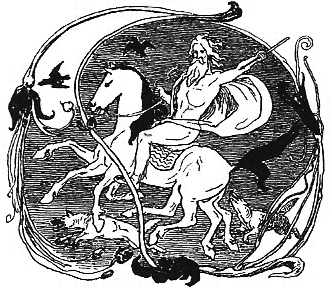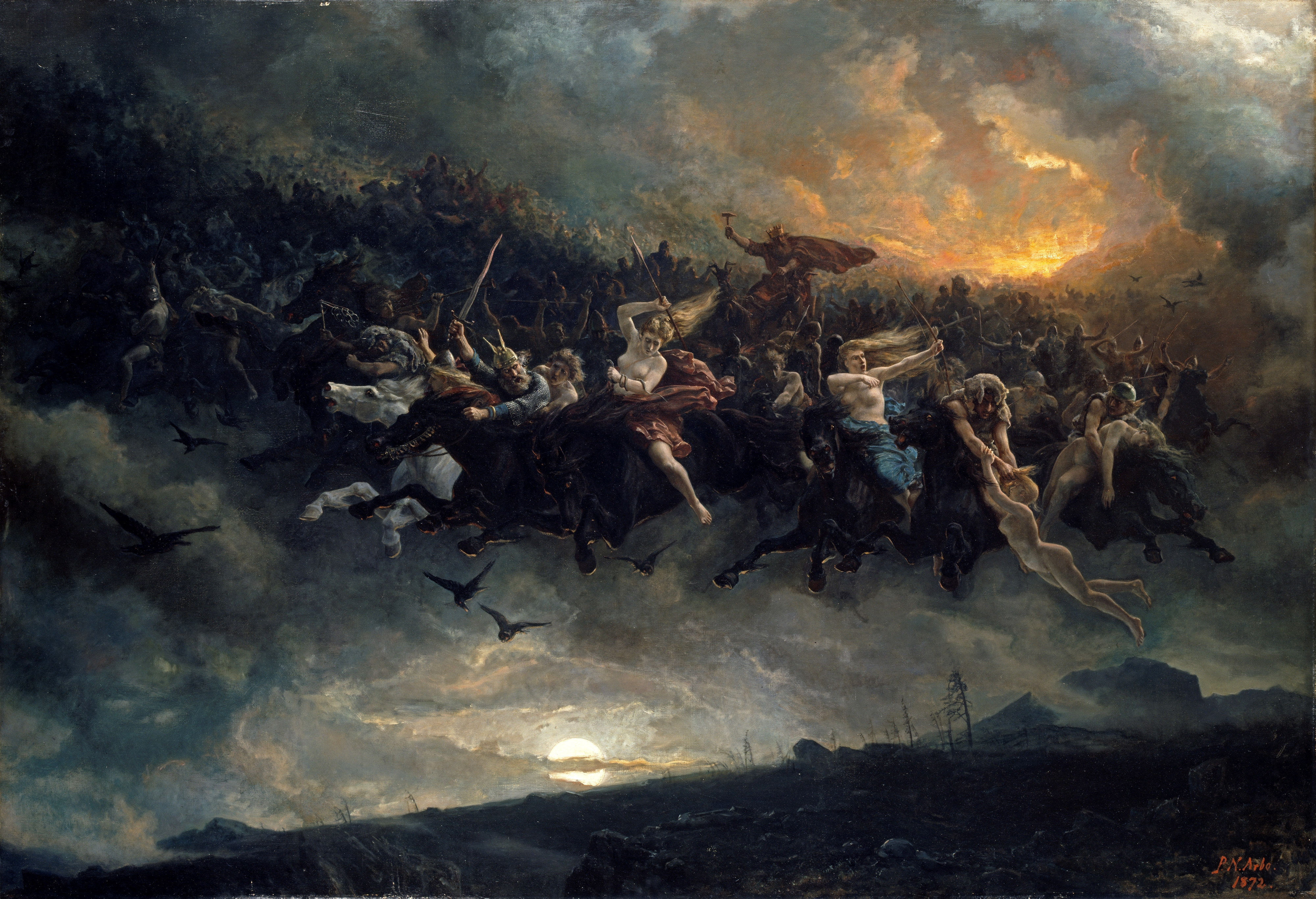|
Guðmundr
Guðmundr (Old Norse: , sometimes anglicised as Godmund) was a semi-legendary Norse king in Jotunheim, ruling over a land called ''Glæsisvellir'', which was known as the warrior's paradise.Otto Höfler, ''Kultische Geheimbünde der Germanen'', volume 1, Frankfurt a. M.: Diesterweg, OCLC 459349888p. 172 Guðmundr appears in the following legendary sagas: *'' Bósa saga ok Herrauðs'' *''Helga þáttr Þórissonar'' *'' Hervarar saga ok Heiðreks'' *''Norna-Gests þáttr'' *''Þorsteins þáttr bæjarmagns'' He also appears in Saxo Grammaticus' ''Gesta Danorum'' (Book VIII) and in '' Samsons saga fagra'', one of the chivalric sagas. Guðmundr shared the same name with his father; '' Úlfhéðinn'' was added to the son's name to differentiate father from son. According to some sources, Guðmundr Úlfhéðinn's son was Heiðrekr Úlfhamr.Ingemar Nordgren, ''The Well Spring of the Goths: About the Gothic Peoples in the Nordic Countries and on the Continent'', New York: iUniverse, 2 ... [...More Info...] [...Related Items...] OR: [Wikipedia] [Google] [Baidu] |
Helga þáttr Þórissonar
''Helga þáttr Þórissonar'' is a ''þáttr'' or short legendary saga found within the ''Ólafs saga Tryggvasonar (Flateyjarbók), Saga of Ólaf Tryggvason'' in the ''Flateyjarbók''. Plot On the way back from a trading voyage to Finnmark with his brother, Helgi Þórisson becomes lost in a foggy wood and meets Ingibjörg, daughter of King Guðmundr, Godmund of Glæsisvellir, and her retinue of 11 women, all wearing red and riding red horses. He sleeps with her for three nights, and as a parting gift she gives him a chest full of gold and another full of silver, but warns him that he must tell no one where they came from. Returning home to Norway, where the brothers live with their father, Þórir, near the Oslofjord, Helgi spends some of the money decorating his and his brother's ship, and hides the rest in its dragon-prow. The following Christmas, a great gale comes up and the brothers are afraid for their ship; checking on it, Helgi is carried off by two men who suddenly appear ... [...More Info...] [...Related Items...] OR: [Wikipedia] [Google] [Baidu] |
Old Norse
Old Norse, Old Nordic, or Old Scandinavian, is a stage of development of North Germanic languages, North Germanic dialects before their final divergence into separate Nordic languages. Old Norse was spoken by inhabitants of Scandinavia and their Viking expansion, overseas settlements and chronologically coincides with the Viking Age, the Christianization of Scandinavia and the consolidation of Scandinavian kingdoms from about the 7th to the 15th centuries. The Proto-Norse language developed into Old Norse by the 8th century, and Old Norse began to develop into the modern North Germanic languages in the mid-to-late 14th century, ending the language phase known as Old Norse. These dates, however, are not absolute, since written Old Norse is found well into the 15th century. Old Norse was divided into three dialects: Old West Norse, ''Old West Norse'' or ''Old West Nordic'' (often referred to as ''Old Norse''), Old East Norse, ''Old East Norse'' or ''Old East Nordic'', and ''Ol ... [...More Info...] [...Related Items...] OR: [Wikipedia] [Google] [Baidu] |
Helgi
Helge or Helgi is a Scandinavian, German, and Dutch mostly male name. The name is derived from Proto-Norse ''Hailaga'' with its original meaning being ''dedicated to the gods''. For its Slavic version, see Oleg. Its feminine equivalent is Olga. Notable people with this name *Halga, legendary Danish king mentioned in ''Beowulf'' and in medieval Scandinavian sources *Helgi Hjörvarðsson, Scandinavian hero from ''Helgakviða Hjörvarðssonar'', in the ''Poetic Edda'' *Helgi Hundingsbane, Scandinavian hero who figures in the ''Völsunga saga'' and who has two poems in the ''Poetic Edda'' *Helgi Haddingjaskati, Swedish hero from ''Hrómundar saga Gripssonar'' *Helge (Danish king), 9th-century king *Helge Akre (1903–1986), Norwegian diplomat *Helge Bostrom (1894–1977), Canadian ice hockey player *Helge Jung (1886–1978), Swedish General *Helgi the Sharp (other), several people *Helgi Tómasson (other), several people *Helge Rosvaenge (1897–1972), Danish-Ge ... [...More Info...] [...Related Items...] OR: [Wikipedia] [Google] [Baidu] |
Lombards
The Lombards () or Langobards ( la, Langobardi) were a Germanic people who ruled most of the Italian Peninsula from 568 to 774. The medieval Lombard historian Paul the Deacon wrote in the ''History of the Lombards'' (written between 787 and 796) that the Lombards descended from a small tribe called the Winnili,: "From Proto-Germanic '' winna-'', meaning "to fight, win" who dwelt in southern Scandinavia (''Scadanan'') before migrating to seek new lands. By the time of the Roman-era - historians wrote of the Lombards in the 1st century AD, as being one of the Suebian peoples, in what is now northern Germany, near the Elbe river. They continued to migrate south. By the end of the fifth century, the Lombards had moved into the area roughly coinciding with modern Austria and Slovakia north of the Danube, where they subdued the Heruls and later fought frequent wars with the Gepids. The Lombard king Audoin defeated the Gepid leader Thurisind in 551 or 552, and his successor Alboin ... [...More Info...] [...Related Items...] OR: [Wikipedia] [Google] [Baidu] |
Valhalla
In Norse mythology Valhalla (;) is the anglicised name for non, Valhǫll ("hall of the slain").Orchard (1997:171–172) It is described as a majestic hall located in Asgard and presided over by the god Odin. Half of those who die in combat enter Valhalla, while the other half are chosen by the goddess Freyja to reside in Fólkvangr. The masses of those killed in combat (known as the Einherjar) along with various legendary Germanic heroes and kings, live in Valhalla until Ragnarök when they will march out of its many doors to fight in aid of Odin against the jötnar. Valhalla is attested in the '' Poetic Edda'', compiled in the 13th century from earlier traditional sources, in the ''Prose Edda'' (written in the 13th century by Snorri Sturluson), in '' Heimskringla'' (also written in the 13th century by Snorri Sturluson), and in stanzas of an anonymous 10th century poem commemorating the death of Eric Bloodaxe known as '' Eiríksmál'' as compiled in '' Fagrskinna''. Va ... [...More Info...] [...Related Items...] OR: [Wikipedia] [Google] [Baidu] |
Óðinn
Odin (; from non, Óðinn, ) is a widely revered god in Germanic paganism. Norse mythology, the source of most surviving information about him, associates him with wisdom, healing, death, royalty, the gallows, knowledge, war, battle, victory, sorcery, poetry, frenzy, and the runic alphabet, and depicts him as the husband of the goddess Frigg. In wider Germanic mythology and paganism, the god was also known in Old English as ', in Old Saxon as , in Old Dutch as ''Wuodan'', in Old Frisian as ''Wêda'', and in Old High German as , all ultimately stemming from the Proto-Germanic theonym *''Wōðanaz'', meaning 'lord of frenzy', or 'leader of the possessed'. Odin appears as a prominent god throughout the recorded history of Northern Europe, from the Roman occupation of regions of Germania (from BCE) through movement of peoples during the Migration Period (4th to 6th centuries CE) and the Viking Age (8th to 11th centuries CE). In the modern period, the rural folklore of Germanic Eu ... [...More Info...] [...Related Items...] OR: [Wikipedia] [Google] [Baidu] |
Theriomorphic
The word ''zoomorphism'' derives from the Greek ζωον (''zōon''), meaning "animal", and μορφη (''morphē''), meaning "shape" or "form". In the context of art, zoomorphism could describe art that imagines humans as non-human animals. It can also be defined as art that portrays one species of animal like another species of animal or art that uses animals as a visual motif, sometimes referred to as "animal style." In ancient Egyptian religion, deities were depicted in animal form which is an example of zoomorphism in not only art but in a religious context. It is also similar to the term therianthropy; which is the ability to shape shift into animal form, except that with zoomorphism the animal form is applied to a physical object. It means to attribute animal forms or animal characteristics to other animals, or things other than an animal; similar to but broader than anthropomorphism. Contrary to anthropomorphism, which views animal or non-animal behavior in human terms, ... [...More Info...] [...Related Items...] OR: [Wikipedia] [Google] [Baidu] |
Picture Stone
A picture stone, image stone or figure stone is an ornate slab of stone, usually limestone, which was raised in Germanic Iron Age or Viking Age Scandinavia, and in the greatest number on Gotland.The article ''Bildstenar'' in ''Nationalencyklopedin'' (1990).Hadenius, Stig; Nilsson, Torbjörn; Åselius, Gunnar (1996) ''Sveriges historia: vad varje svensk bör veta''. Bonnier Alba, Borås. p. 28. More than four hundred picture stones are known today.A presentation at the County Museum of Gotland. All of the stones were probably erected as memorial stones, but only rarely beside graves. Some of them have been positioned where many people could see them at bridges and on roads. They mainly differ from |
Sleipnir
In Norse mythology, Sleipnir (Old Norse: ; "slippy"Orchard (1997:151). or "the slipper"Kermode (1904:6).) is an eight-legged horse ridden by Odin. Sleipnir is attested in the ''Poetic Edda'', compiled in the 13th century from earlier traditional sources, and the ''Prose Edda'', written in the 13th century by Snorri Sturluson. In both sources, Sleipnir is Odin's steed, is the child of Loki and Svaðilfari, is described as the best of all horses, and is sometimes ridden to the location of Hel (location), Hel. The ''Prose Edda'' contains extended information regarding the circumstances of Sleipnir's birth, and details that he is grey in color. Sleipnir is also mentioned in a riddle found in the 13th century legendary saga ''Hervarar saga ok Heiðreks'', in the 13th-century legendary saga ''Völsunga saga'' as the ancestor of the horse Grani, and book I of ''Gesta Danorum'', written in the 12th century by Saxo Grammaticus, contains an episode considered by many scholars to involve Sl ... [...More Info...] [...Related Items...] OR: [Wikipedia] [Google] [Baidu] |
Otto Höfler
Otto Eduard Gotfried Ernst Höfler (10 May 1901 – 25 August 1987) was an Austrian philologist who specialized in Germanic studies. A student of Rudolf Much, Höfler was Professor and Chair of German Language and Old German Literature at the University of Vienna. Höfler was also a Nazi from 1922 and a member of the SS Ahnenerbe before the Second World War. Höfler was a close friend of Georges Dumézil and Stig Wikander, with whom he worked closely on developing studies on Indo-European society. He tutored a significant number of future prominent scholars at Vienna, and was the author of works on early Germanic culture. refers to him as "perhaps most famous and probably most controversial representative" of the "Vienna School" of Germanic studies founded by Much. Early life and education Otto Höfler was born in Vienna on 10 May 1901 to a highly educated upper middle class family. His father, Alois Höfler, was Professor of Philosophy and Pedagogy at the University of Vienna. ... [...More Info...] [...Related Items...] OR: [Wikipedia] [Google] [Baidu] |
Oskorei
The Wild Hunt is a folklore motif (Motif E501 in Stith Thompson's Motif-Index of Folk-Literature) that occurs in the folklore of various northern European cultures. Wild Hunts typically involve a chase led by a mythological figure escorted by a ghostly or supernatural group of hunters engaged in pursuit. The leader of the hunt is often a named figure associated with Odin in Germanic legends, but may variously be a historical or legendary figure like Theodoric the Great, the Danish king , the Welsh psychopomp , biblical figures such as Herod, Cain, Gabriel, or the Devil, or an unidentified lost soul or spirit either male or female. The hunters are generally the souls of the dead or ghostly dogs, sometimes fairies, valkyries, or elves. Seeing the Wild Hunt was thought to forebode some catastrophe such as war or plague, or at best the death of the one who witnessed it. People encountering the Hunt might also be abducted to the underworld or the fairy kingdom. In some instan ... [...More Info...] [...Related Items...] OR: [Wikipedia] [Google] [Baidu] |




.jpg)
